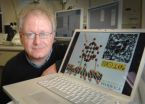(Press-News.org) The November 2010 issue of "Environmental Pollution" details successful experiments at the University of Cincinnati wherein rabbit's food resulted in the abiotic (non-biological) transformation and absorption of four different types of estrogen, reducing the levels of these estrogen hormones by more than 80 percent in wastewater.
The research has practical implications since it could point to inexpensive treatment technologies and materials for reducing estrogens in wastewater.
Currently, estrogen in wastewater represents a major conduit for the entry of the hormone, whether in its naturally occurring forms or synthetic form (birth-control pills), into the environment. There, it's believed the hormone causes responses in the endocrine systems of fish, birds and other wildlife in and around streams and rivers, groundwater, sediments and sludge. In other words, causing effects in wildlife such as the presence of both male and female sex organs, feminization of males, abnormal and malformed reproductive organs, skewed sex ratios, reduced fertility and more.
Population growth and the use of synthetic estrogens (birth-control pills) have increased the presence of the hormone (both in its naturally occurring forms and its synthetic forms) in the environment.
RABBIT FOOD AND THE ESTROGEN EFFECT
In an article titled "Abiotic Transformation of Estrogen in Synthetic Municipal Wastewater: An Alternative for Treatment" in this month's issue of Environmental Pollution, authors Makram Suidan, UC professor of environmental engineering; Mark Mills, research engineer with the U.S. Environmental Protection Agency's National Risk Management Research Laboratory; and Ruth Marfil-Vega, UC doctoral student in environmental engineering, detail their success in harnessing natural materials in improving the removal of estrogen from the environment.
The experiments hold great promise, according to lead author Makram Suidan because "it would be an inexpensive process to replicate in wastewater treatment plants and because the UC experiments with the rabbit food proved effective in dramatically reducing the levels of naturally occurring estrogens but also the synthetic estrogen, which typically has the longest staying power in wastewater and the environment."
While the UC team tested a variety of materials – clays, casein (a protein molecule found in cheese and milk), tryptone (an amino acid) and starch – only the rabbit food proved effective in greatly reducing estrogen levels. In fact, in testing the clays, casein, typtone and starch for effects on wastewater hormone levels, the UC experiments found that these four alternate materials only reduced wastewater estrogen levels by 10 percent.
Stated Suidan, "We are now experimenting to find out, specifically, why the rabbit food proved so effective in reducing estrogen levels. Rabbit food was a material we chose because, unlike dog food, rabbit food is hormone free. Rabbit food is merely ground up, organic vegetable matter – not unlike vegetable matter that could safely be added to wastewater."
The experiments were repeated several times using synthetic wastewater in stainless steel containers (to avoid any absorption of the tested hormones that might have been possible with plastic containers). As stated, the rabbit food reduced the levels of the four estrogens by more than 80 percent after a 72-hour contact period.
Explained Suidan, "While absorption of estrogen by the rabbit food played some role, we believe that a catalytic process occurred, meaning the estrogen compounds appeared to bind to the rabbit food when oxygen was present."
NO EFFECT ON MALE HORMONS FOUND IN WASTEWATER
In the experiments, the UC team not only tested materials that might reduce estrogen levels in wastewater but also tested the efficacy of these same materials (rabbit food, casein, clays, tryptone and starch) in reducing the levels of male hormones (testosterone, androstenedione and progesterone) in wastewater.
However, none of the treatment materials – including the rabbit food – had any effect on the presence of these male hormone levels in the wastewater.
INFORMATION:
The research was internally funded.
UC research: Rabbit's food brings luck in decreasing estrogen levels in wastewater
2010-11-02
ELSE PRESS RELEASES FROM THIS DATE:
Antibiotics have long-term impacts on gut flora
2010-11-02
Short courses of antibiotics can leave normal gut bacteria harbouring antibiotic resistance genes for up to two years after treatment, say scientists writing in the latest issue of Microbiology, published on 3 November.
The researchers believe that this reservoir increases the chances of resistance genes being surrendered to pathogenic bacteria, aiding their survival and suggesting that the long-term effects of antibiotic therapy are more significant than previously thought.
Antibiotics that are prescribed to treat pathogenic bacteria also have an impact on the normal ...
Childhood stroke study identifies the contraceptive pill and smoking as risk factors
2010-11-02
Researchers are calling for clear guidelines on childhood stroke after a study, published in the November issue of Acta Paediatrica, found wide variations in time lag to diagnosis, investigation and treatment.
They are also keen to see the development of appropriate rehabilitation services, after a follow-up study found that 85% of the children who survived a stroke had neurological dysfunction or limitations.
Dr Sten Christerson studied the records of all children who had experienced their first stroke over a seven-year period in the Uppsala-Orebro Health Care Region, ...
Arthritis drugs could help prevent memory loss after surgery, study suggests
2010-11-02
Anti-inflammatory drugs currently used to treat diseases such as rheumatoid arthritis may also help prevent cognitive problems after surgery, according to a new study by researchers at Imperial College London and University of California, San Francisco (UCSF).
The research also reveals for the first time that a specific inflammatory response in the brain may explain why many patients experience memory loss or other forms of cognitive dysfunction after surgery or critical illness.
The findings, from research in mouse models, could lead to human clinical trials within ...
Quantum computing with braids in flatland
2010-11-02
When confined to a 2-dimensional sheet, some exotic particle-like structures known as anyons appear to entwine in ways that could lead to robust quantum computing schemes, according to research appearing in the November 1 issue of the journal Physical Review B. The physicists at Bell Laboratories who performed the research are hopeful the anyons can be induced to follow paths that twist into braids that would be much more resistant to disturbances that corrupt data and calculations in quantum computers relying on individual particles.
The anyons the researchers believe ...
Virginia Tech computer scientist, student design award winning software to combat hacking
2010-11-02
One of the serious threats to a user's computer is a software program that might cause unwanted keystroke sequences to occur in order to hack someone's identity. This form of an attack is increasing, infecting enterprise and personal computers, and caused by "organized malicious botnets," said Daphne Yao, assistant professor of computer science at Virginia Tech (http://www.cs.vt.edu/user/115).
To combat the "spoofing attacks," Yao and her former student, Deian Stefan, now a graduate student in the computer science department at Stanford University, developed an authentication ...
Typists' errors and intention theories
2010-11-02
New research published today in the journal Science says people think about things they think they don't think about. Vanderbilt University psychologists Gordon Logan and Matthew Crump say when highly skilled people such as surgeons, carpenters, or pilots perform actions without thinking, those actions are highly controlled. The finding adds key information to a debate on whether people consciously perform actions in which they are highly skilled.
Previous research suggests conscious control of driving a car for an experienced driver, for example, is an illusion. These ...
Race may influence uterine cancer recurrence, despite treatment
2010-11-02
DETROIT – African Americans are more likely to have a recurrence of uterine cancer despite undergoing a total hysterectomy or a hysterectomy followed by radiation therapy, according to researchers at Henry Ford Hospital in Detroit.
"The African American patients in our study had similar surgeries and radiation therapy as the Caucasian patients in the study. So access to care certainly wasn't a factor in race being identified as a negative predictor for outcome," says lead author Mohamed Elshaikh, M.D., senior staff physician in the Department of Radiation Oncology at ...
NPL builds long range alpha detector
2010-11-02
The UK's National Physical Laboratory (NPL) has developed a new portable radiation detector that can assess the safety of potentially contaminated areas far quicker than current methods. The prototype was inspired by the aftermath of the murder of Alexander Litvinenko in London 2006.
Litvinenko's death was due to radiation poisoning from polonium-210. It prompted wide-scale work to assess radiation levels at almost 50 premises in London that he had been prior to his death before opening them up again to the public, costing the Health Protection Agency £2 million.
The ...
Pivoting hooks of graphene's chemical cousin could revolutionize work of electron microscopes
2010-11-02
The single layer material Graphene was the subject of a Nobel prize this year but research led by a team of researchers at the University of Warwick has found molecular hooks on the surface of its close chemical cousin, Graphene Oxide, that will potentially provide massive benefits to researchers using transmission electron microscopes. They could even be used in building molecular scale mechanisms.
The research team, which includes Drs. Jeremy Sloan, Neil Wilson and PhD student Priyanka Pandey from the Department of Physics and Dr. Jon Rourke from the Department of Chemistry ...
New strain of 'high-runner' rats uniquely resistant to disease -- all disease!
2010-11-02
Everybody knows that if you're physically fit, you're less likely to get a wide range of diseases. What most people don't know is that some people are "naturally" in better shape than others, and this variation in conditioning makes it difficult to test for disease risk and drug effectiveness in animal models. A new research paper published in the November 2010 print issue of The FASEB Journal (http://www.faseb.org) started out as a study to explain the strong statistical link between low aerobic exercise capacity and common diseases, but ultimately led to an animal model ...


